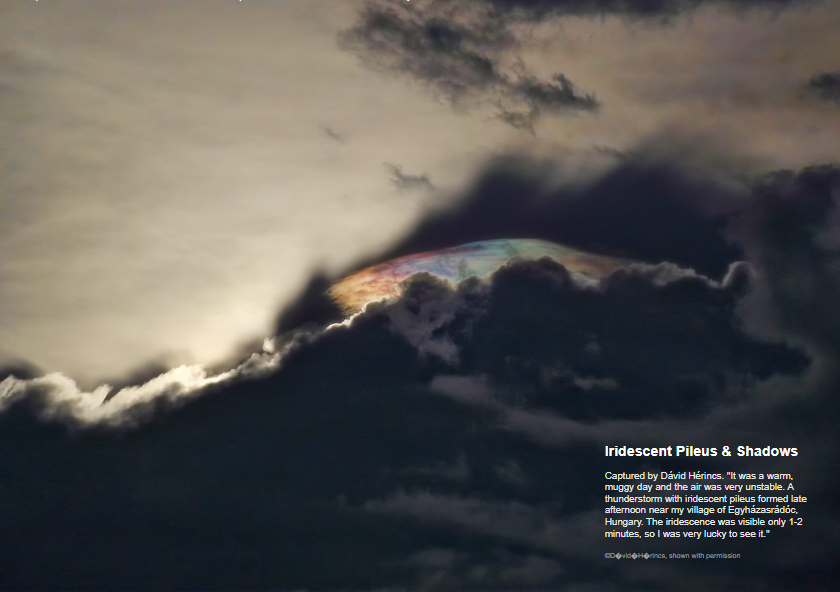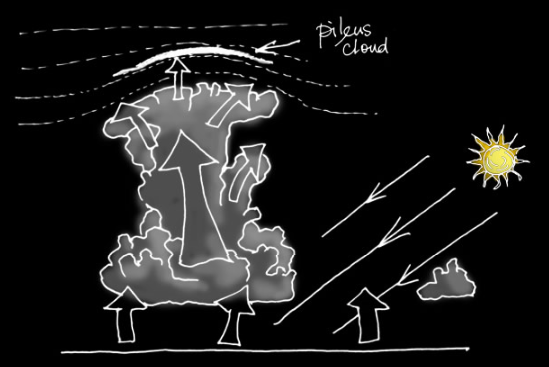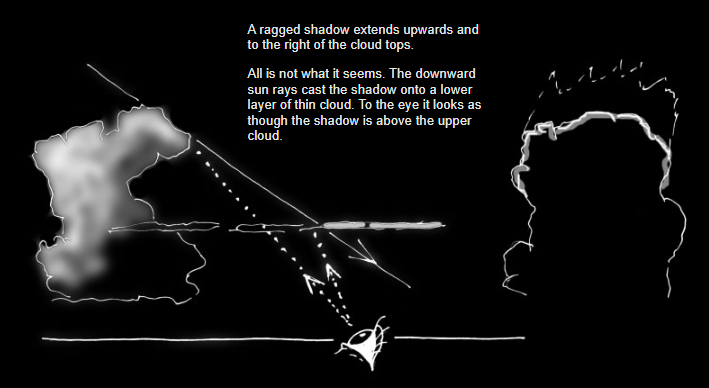OPOD - Pileus & Shadows
OPOD - Pileus & Shadows: A Spectacular Atmospheric Phenomenon
Have you ever witnessed a captivating display of iridescent colors in the sky, only to see them disappear within a matter of minutes? If so, you may have been fortunate enough to witness an iridescent pileus cloud. In this article, we will delve into the mesmerizing world of pileus clouds and the intriguing shadows they cast.
The Formation of Pileus Clouds
Pileus clouds, also known as cap clouds, are thin and translucent clouds that form above cumulus clouds on hot and humid days. As warm air rises from the sun-heated ground, it expands and cools. If the air is sufficiently humid, the moisture condenses to form cumulus clouds. Throughout the day, these clouds continue to grow upwards as more moisture condenses within them.
The upward motion of the unstable air mass causes the layers above the cloud tops to be pushed upwards as well. When these upper layers contain enough moisture, the sudden expansion and cooling caused by the upward movement result in the rapid condensation of droplets, forming a thin layer of cloud known as a pileus cloud.
The Spectacle of Iridescent Pileus Clouds
What makes pileus clouds truly remarkable is their ability to diffract sunlight at high altitudes, creating a breathtaking display of iridescence. The droplets within pileus clouds are all of similar size and do not have time to evolve, making them ideal for diffracting sunlight into vibrant colors. However, this iridescence is short-lived, often lasting only one to two minutes. Therefore, witnessing this phenomenon is truly a stroke of luck.
The Illusion of Shadows
Accompanying the iridescent pileus clouds is another intriguing phenomenon – the appearance of ragged shadows extending upwards and to the right of the cloud tops. At first glance, it may seem as though these shadows are located above the upper cloud layer. However, this is merely an optical illusion.
The downward rays of the sun cast these shadows onto a lower layer of thin clouds. Due to the angle at which the shadows are cast, they appear to be positioned above the cumulus clouds. This illusion adds an extra layer of visual complexity to the already captivating scene.
Exploring Atmospheric Optics
Atmospheric optics is a field of study that investigates the various optical phenomena occurring in the Earth's atmosphere. These phenomena range from the familiar rainbows and halos to lesser-known occurrences like iridescent pileus clouds and their accompanying shadows.
By studying these atmospheric optics phenomena, scientists gain insights into the intricate interactions between light, moisture, and air particles in our atmosphere. These studies not only deepen our understanding of our planet's natural processes but also provide us with awe-inspiring spectacles that can be enjoyed by anyone fortunate enough to witness them.
Conclusion
The world of atmospheric optics is full of wonders waiting to be discovered. The ethereal beauty of iridescent pileus clouds and their intriguing shadows serve as a reminder of the complexity and splendor of nature. So, keep your eyes on the sky, for you never know when you might catch a glimpse of these mesmerizing atmospheric phenomena.

Iridescent Pileus & Shadows
Captured by Dávid Hérincs. "It was a warm, muggy day and the air was very unstable. A thunderstorm with iridescent pileus formed late afternoon near my village of Egyházasrádóc, Hungary. The iridescence was visible only 1-2 minutes, so I was very lucky to see it."
©D�vid�H�rincs, shown with permission

Air pressure decreases with height. An ascending isolated pocket of moist air expands and adiabatically cools because expansion requires work to be done against the surroundings. With sufficient cooling some of the pocket's water vapour condenses out into small droplets

The story of thin and translucent pileus or cap cloud starts with the development of lower and much thicker cumulus on a hot and humid day.
Warm air rises from sun heated ground. It expands and cools as it climbs. If its humidity is sufficient then moisture condenses out to form cumulus cloud. As the day proceeds the cloud grows upwards with yet more condensation. The condensation releases heat which accelerates further the upward motions in the unstable mass. In extremis we get a thunderous cloud mass towering several kilometres.
All this pushes the air layers above the cloud tops upwards. If a layer is moist then the upward travel causes expansion, cooling and sudden condensation into a thin cloud of droplets - a pileus cloud.
The rapid condensation into pileus is important. The droplets are all of similar size and do not have time to evolve. Ideal material to diffract the high altitude sunlight into bright iridescence.

A ragged shadow extends upwards and to the right of the cloud tops.
All is not what it seems. The downward sun rays cast the shadow onto a lower layer of thin cloud. To the eye it looks as though the shadow is above the upper cloud.
Note: this article has been automatically converted from the old site and may not appear as intended. You can find the original article here.
Reference Atmospheric Optics
If you use any of the definitions, information, or data presented on Atmospheric Optics, please copy the link or reference below to properly credit us as the reference source. Thank you!
-
<a href="https://atoptics.co.uk/blog/opod-pileus-shadows/">OPOD - Pileus & Shadows</a>
-
"OPOD - Pileus & Shadows". Atmospheric Optics. Accessed on July 27, 2024. https://atoptics.co.uk/blog/opod-pileus-shadows/.
-
"OPOD - Pileus & Shadows". Atmospheric Optics, https://atoptics.co.uk/blog/opod-pileus-shadows/. Accessed 27 July, 2024
-
OPOD - Pileus & Shadows. Atmospheric Optics. Retrieved from https://atoptics.co.uk/blog/opod-pileus-shadows/.